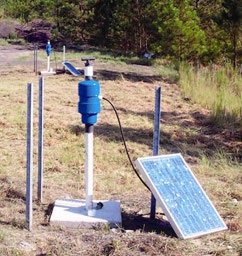Tech Briefs
Savannah River National Laboratory
MicroBlower:
Subsurface remediation tool
The MicroBlower uses a small, low power vacuum blower to extract or inject gases into the subsurface for characterization or remediation. Because the components of the system have a long operating life, the system is useful for long-term cleanup operations, particularly where mass transfer limits the rate of remediation.
The unit can be powered by small batteries, small photovoltaic panels, or wind generators.
At a glance
- Long operating life
- Solar powered
- Remediates shallow areas
- Remediates vadose zone
- Excellent for treatment polishing
- Offers significant cost savings
- U. S. Patent 6,971,820
Ideal for long-term remediation
The MicroBlower addresses these considerations for long-term remediation systems.
Pumping: The pump is capable of producing environmentally relevant flows (i.e., greater than 1 scfm) at pressures or vacuums typical of subsurface situations.
Power: The system requires only between 20 and 40 watts of power, which can be easily produced by a small photovoltaic panel.
Size: The pumps in the system are small and unobtrusive for long-term operations – 4 inches in height and 3 inches in diameter.
Reliability: The mean time between failures for the pumps is on the order of 15,000 to 20,000 hours.

Widespread potential
The MicroBlower enables the use of simple, low-cost soil vapor extraction in shallower areas than previously considered possible.
Perhaps the greatest potential for the MicroBlower is in treatment polishing of an area treated by an expensive, large blower system that still has residual contamination. Installation of an economical MicroBlower system to finish the cleanup at greatly reduced costs allows the larger systems to be used where they can produce greater returns.
The MicroBlower also can remediate sites that are smaller than the capacity of typical, large blower systems.
Offers cost savings
This technology has the potential to offer significant cost savings to the groundwater remediation industry. Presently, there are no regulations concerning the contaminants in the vadose zone. However, if the vadose zone is not remediated, contamination will migrate downward and recontaminate the groundwater. With the groundwater no longer in compliance, the responsible parties must bear the cost of remediating the groundwater again. By installing the MicroBlower, the risk of the groundwater being recontaminated from the vadoze zone would be alleviated.
Verified performance
During a 10-month period, a MicroBlower removed 234 pounds of volatile organic compounds from a contaminated groundwater plume beneath the Savannah River Site (SRS).
Partnering opportunities
SRNL invites interested companies with proven capabilities in this area of expertise to enter into a licensing agreement with SRNL to market this nuclear material detection system. Interested companies will be requested to submit a business plan setting forth company qualifications, strategies, activities, and milestones for commercializing this invention.
Qualifications should include past experience at bringing similar products to market, reasonable schedule for product launch, sufficient manufacturing capacity, established distribution networks, and evidence of sufficient financial resources for product development and launch.
Download Tech Brief
Contact Information
Savannah River National Laboratory
E-mail: partnerships@srnl.doe.gov